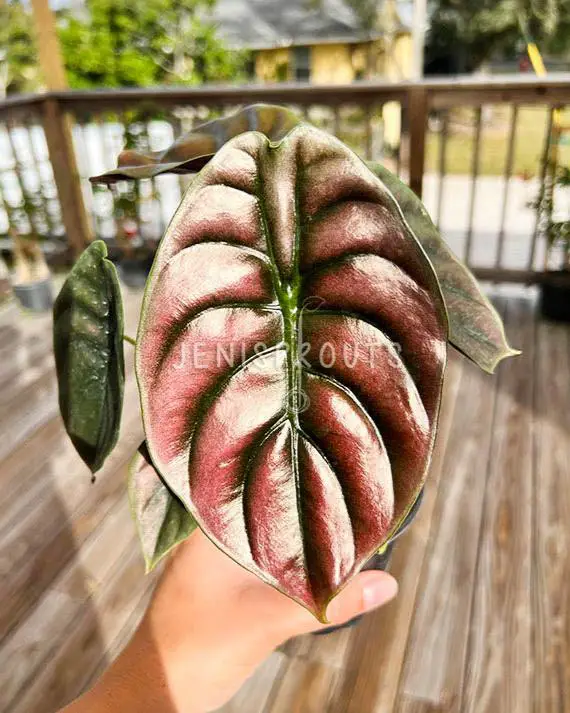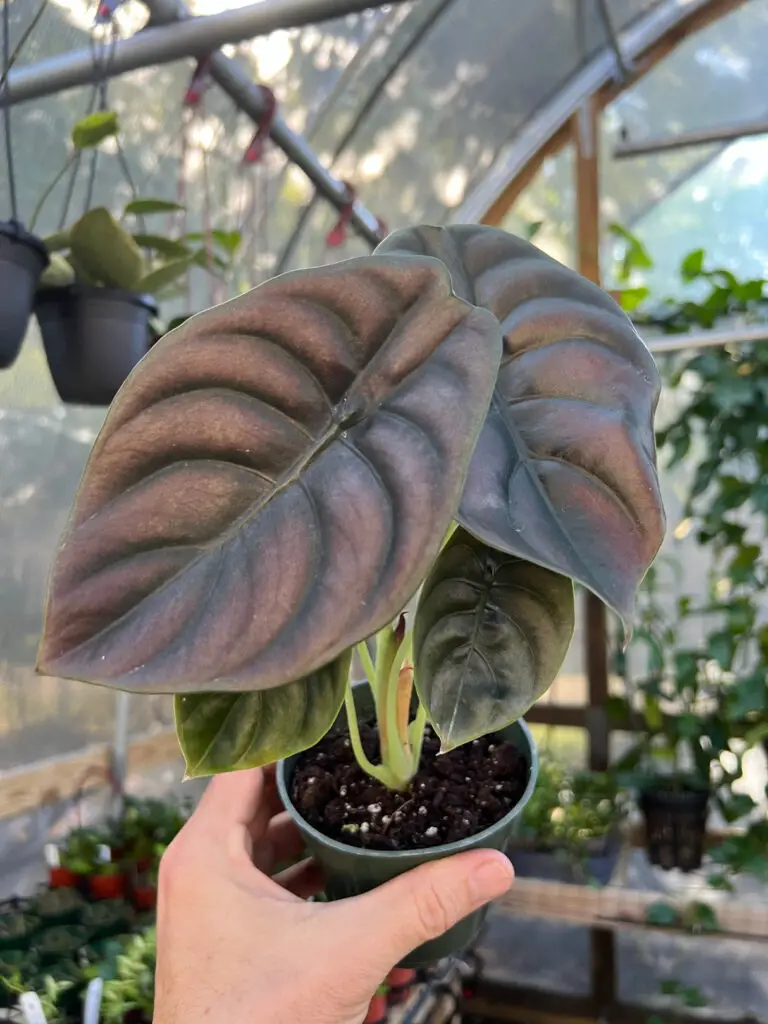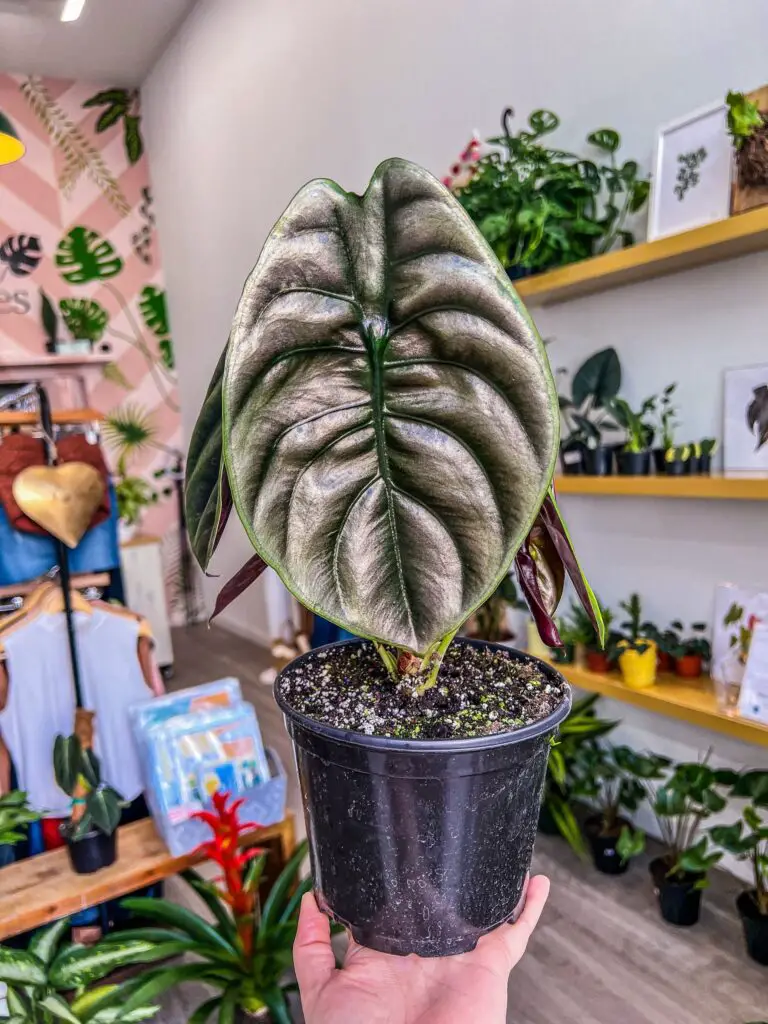The Alocasia Cuprea Red Secret thrives in bright, indirect light and requires high humidity and well-draining soil. Water it when the top inch of soil feels dry. Fertilize every month during the growing season and keep it warm, ideally between 65°F to 85°F. Avoid overwatering to prevent root rot.
Understanding Alocasia Cuprea Red Secret
The Alocasia Cuprea, commonly known as the Red Secret, is a stunning tropical plant native to Southeast Asia. This plant is celebrated for its unique, heart-shaped leaves that feature a striking deep green color with prominent red veins. Its stunning appearance makes it a popular choice among plant enthusiasts and collectors.

As a member of the Araceae family, Alocasia Cuprea is often referred to as an elephant ear plant due to the shape of its leaves. The Red Secret variety stands out because of its vibrant color contrasts and distinctive leaf texture. Caring for this plant can be rewarding, but it requires specific conditions to thrive. Understanding its needs is essential for maintaining its health and beauty.
Optimal Growing Conditions
Creating an ideal environment for your Alocasia Cuprea Red Secret is crucial. This plant prefers certain conditions that mimic its natural habitat. Here are some key elements to consider:
- Light: Bright, indirect light is ideal. Direct sunlight can scorch the leaves, while too little light can hinder growth.
- Humidity: High humidity levels (around 60% or higher) are preferred. Using a humidifier or placing a pebble tray with water beneath the pot can help maintain moisture.
- Temperature: The ideal temperature range is between 65°F to 85°F. Sudden temperature drops or drafts should be avoided.
Watering Requirements
Watering is a critical aspect of caring for your Alocasia Cuprea Red Secret. Here are some guidelines to follow:
- Water the plant when the top inch of soil feels dry. This ensures that the roots receive adequate moisture without becoming waterlogged.
- During the growing season, typically spring and summer, your plant may require more frequent watering due to increased evaporation and growth rates.
- In fall and winter, reduce watering as the plant enters a dormant period. Overwatering can lead to root rot, a common issue with Alocasia plants.
Soil and Fertilization
The right soil mix plays a significant role in the health of your Alocasia Cuprea Red Secret. Here’s what you should know:
| Soil Type | Description |
|---|---|
| Well-Draining Soil | A mix of potting soil, perlite, and orchid bark works well for good drainage. |
| pH Level | Aim for a slightly acidic to neutral pH level (5.5-7.0). |
Fertilization is also important. During the growing season, use a balanced liquid fertilizer every month to provide essential nutrients. In fall and winter, reduce feeding as the plant’s growth slows down.
Pest Management
Pests can pose a threat to the health of your Alocasia Cuprea Red Secret. Here are some common pests to watch for:

- Spider Mites: Look for tiny webs on the undersides of leaves.
- Aphids: Check for sticky residue or discolored leaves.
- Mealybugs: Identify them by their white, cotton-like appearance.
If pests are detected, treat them promptly with insecticidal soap or neem oil to protect your plant’s vitality.
Propagation Techniques
Propagating your Alocasia Cuprea Red Secret can be a rewarding experience. It allows you to expand your collection or share with friends. There are several effective methods for propagation, including division and offsets. Each method has its own steps and considerations.
Division Method
The division method involves separating the plant into multiple sections, each with its own root system. Here’s how to do it:
- Choose the Right Time: The best time to propagate is during the growing season, typically in spring or early summer.
- Prepare Your Tools: Use clean, sharp scissors or a knife to prevent any potential infections.
- Remove the Plant: Gently remove the Alocasia from its pot, taking care not to damage the roots.
- Separate the Roots: Locate the natural divisions in the root system. Carefully pull apart or cut the roots to create separate sections.
- Repot the Divisions: Place each section into its own pot filled with fresh, well-draining soil. Water lightly after repotting.
Offsets Method
Offsets are small plants that grow at the base of the parent plant. These can be removed and planted separately. Follow these steps for successful offset propagation:

- Identify Offsets: Look for small plants sprouting near the base of the main plant.
- Gently Remove Offsets: Carefully detach them from the parent plant, ensuring you get some roots attached.
- Potting Offsets: Place each offset in a small pot with suitable soil and water lightly.
Both methods can yield healthy new plants when done correctly. Always ensure that each new plant has enough light, humidity, and water as they establish themselves.
Common Issues and Troubleshooting
Caring for an Alocasia Cuprea Red Secret can sometimes lead to challenges. Understanding common issues will help you maintain a healthy plant.
Leaf Yellowing
Yellowing leaves can indicate several underlying problems:
- Overwatering: This is often the main cause. Ensure the top inch of soil is dry before watering again.
- Lack of Light: If your plant is not receiving sufficient light, it may start to yellow. Move it to a brighter location.
- Nutrient Deficiency: A lack of essential nutrients can also cause yellowing. Regular fertilization can prevent this issue.
Leaf Dropping
If your Alocasia Cuprea is dropping leaves, it may be due to stress factors:
- Temperature Fluctuations: Avoid placing your plant near drafts or heating vents that can cause temperature changes.
- Improper Watering: Both overwatering and underwatering can lead to leaf drop. Maintain a consistent watering schedule.
- Pest Infestation: Pests can stress the plant, leading to leaf drop. Regular inspections can help catch these issues early.
Seasonal Care Adjustments
The care requirements for your Alocasia Cuprea Red Secret may change with the seasons. Adjusting your care routine is important for optimal growth throughout the year.
Spring and Summer Care
During the growing season, your plant will be most active. Here are some adjustments to make:
- Increase Watering: As temperatures rise, monitor soil moisture more frequently and adjust your watering schedule accordingly.
- Add Fertilizer: Use a balanced fertilizer every month to support growth during this active period.
- Ensure Adequate Light: Position your plant to receive bright, indirect sunlight to promote healthy leaf development.
Fall and Winter Care
As temperatures drop, your plant will slow down. Here’s how to adapt:
- <
- Avoid Fertilizing: Skip fertilization during this period as the plant’s nutrient needs decrease.
- Maintain Humidity: Keep humidity levels high, especially in dry winter months, to prevent stress on the plant.
li>Reduce Watering: Allow the top inch of soil to dry out between waterings to prevent root rot during dormancy.
By adjusting care based on seasonal changes, you can keep your Alocasia Cuprea Red Secret thriving year-round.
Safety and Toxicity Considerations
When caring for plants, it’s essential to consider their safety, especially if you have pets or children at home. The Alocasia Cuprea Red Secret is known to be toxic if ingested. Understanding its toxicity will help you manage your plant safely.
Toxicity to Pets and Humans
The Alocasia Cuprea contains calcium oxalate crystals, which can cause irritation and discomfort if ingested. Here’s what to keep in mind:
- Symptoms of Ingestion: If ingested, symptoms can include swelling of the mouth, throat, and tongue, leading to difficulty swallowing. Other symptoms may include drooling, vomiting, and stomach upset.
- Pet Safety: Pets such as cats and dogs may also experience similar symptoms if they chew on the leaves. Keep the plant out of reach of curious pets.
- Child Safety: Educate children about not eating any part of the plant. Consider placing it in an area that is difficult for young children to access.
Common Varieties of Alocasia
The Alocasi
a Cuprea Red Secret is just one of many varieties in the Alocasia family. Each variety has its own unique characteristics and care requirements. Here are a few notable varieties:
| Variety | Description |
|---|---|
| Alocasia Polly | Known for its striking arrow-shaped leaves with silvery veins. |
| Alocasia Zebrina | Features zebra-like striped stems, adding a unique visual appeal. |
| Alocasia Macrorrhiza | This variety has large, dramatic leaves that can grow quite large. |
Each of these varieties requires similar care in terms of light, humidity, and soil conditions. However, slight variations may exist based on their specific needs.
Indoor vs. Outdoor Cultivation
Deciding whether to grow your Alocasia Cuprea Red Secret indoors or outdoors depends on your climate and space. Both options have advantages and challenges.
Indoor Cultivation
When grown indoors, the Alocasia Cuprea can thrive with proper care. Consider the following:
- Controlled Environment: Indoors, you can control light, humidity, and temperature more easily, which is beneficial for the plant’s growth.
- Protection from Pests: Indoor plants are generally less susceptible to outdoor pests and harsh weather conditions.
- Space Considerations: Ensure that the indoor location has enough space for the plant to grow without obstruction.
Outdoor Cultivation
If you live in a suitable climate (typically USDA zones 9-11), outdoor cultivation can be rewarding:
- Natural Light: Outdoor plants benefit from natural sunlight, promoting healthy growth and vibrant colors.
- Higher Humidity: Being outside often provides more humidity, which is ideal for tropical plants like Alocasia.
- Pest Awareness: Keep an eye out for outdoor pests that may target your plant. Regular inspections are key to preventing infestations.
Regardless of where you choose to cultivate your Alocasia Cuprea Red Secret, ensure that it receives appropriate light and humidity levels for optimal health.
Decorative Uses and Aesthetic Appeal
The Alocasi
a Cuprea Red Secret is not just a plant; it is a stunning decorative element that can enhance any space. Its unique leaf shape and color can complement various design styles.
Interior Design Applications
Here are some ways you can incorporate this beautiful plant into your decor:
- Liven Up Living Areas: Use it as a focal point in living rooms or entryways. Its vibrant leaves can add life to any space.
- Create Green Corners: Group it with other houseplants for a lush indoor garden effect.
- Add Height: Place it on a pedestal or plant stand to showcase its stunning foliage.
Outdoor Design Applications
If grown outdoors, consider these design ideas:
- Garden Borders: Use it as part of a colorful border in garden beds along paths or patios.
- Potted Displays: Combine it with other tropical plants in large pots to create an inviting atmosphere on patios or decks.
- Shade Gardens: The Alocasia Cuprea thrives in partial shade, making it an excellent
Enhancing Your Space with Alocasia Cuprea
The Alocasia Cuprea Red Secret not only serves as a beautiful plant but also plays a significant role in enhancing the aesthetic of your environment. Its unique visual appeal can complement various interior styles, from modern to bohemian.
When implementing this plant into your design, consider the following:
- Color Coordination: The rich green leaves with red veins can harmonize with other decor elements. Incorporate accessories that echo these colors to create a cohesive look.
- Texture Play: The glossy leaves contrast beautifully with matte surfaces. Use this contrast to your advantage by placing the plant next to textured items like woven baskets or rustic wood furniture.
- Seasonal Decor: Change the accessories around your Alocasia Cuprea seasonally. For example, pair it with autumn-themed decorations in fall or vibrant florals in spring for a refreshing look.
Maintenance Tips for Long-Term Health
To keep your Alocasia Cuprea Red Secret thriving for years, consider these long-term care tips:
- Regular Cleaning: Dust can accumulate on the leaves, hindering photosynthesis. Wipe them gently with a damp cloth every couple of weeks to keep them clean and healthy.
- Monitor Growth: Pay attention to how your plant is growing. If it becomes root-bound, consider repotting it into a larger container to promote better growth.
- Adjust Care as Needed: Be flexible with your care routine. If you notice any changes in the plant’s health, such as wilting or discoloration, reassess its environment and care practices.
Final Thoughts
Caring for an Alocasia Cuprea Red Secret can be an enjoyable and fulfilling experience. With its stunning foliage and unique characteristics, it adds charm to any home or garden. Understanding its specific needs—such as light, humidity, and watering—ensures that your plant remains healthy and vibrant.
Incorporating the Alocasia into your decor not only enhances the visual appeal of your space but also brings a touch of nature indoors. Whether you choose to grow it indoors or outdoors, its adaptability allows for various creative applications.
Remember to stay vigilant about potential pests and issues, while also enjoying the beauty this plant offers. With patience and proper care, your Alocasia Cuprea Red Secret can flourish, becoming a centerpiece in your botanical collection.
In conclusion, this remarkable plant is not just a delightful addition to your home; it serves as a testament to the beauty of nature and the joy of nurturing living things. Embrace the journey of caring for your Alocasia Cuprea Red Secret, and watch it thrive in your care.
